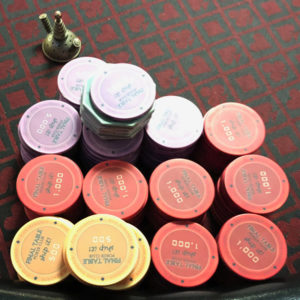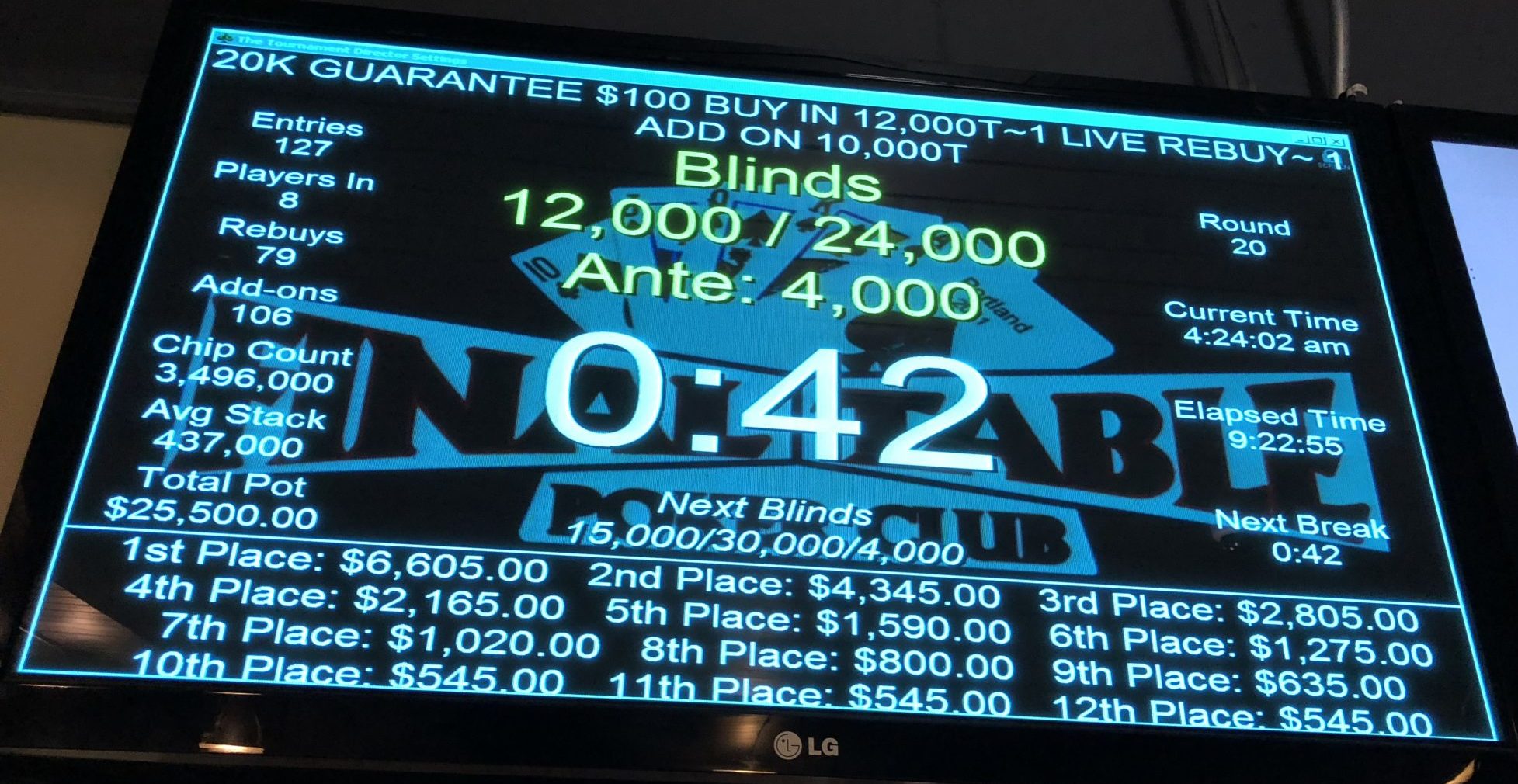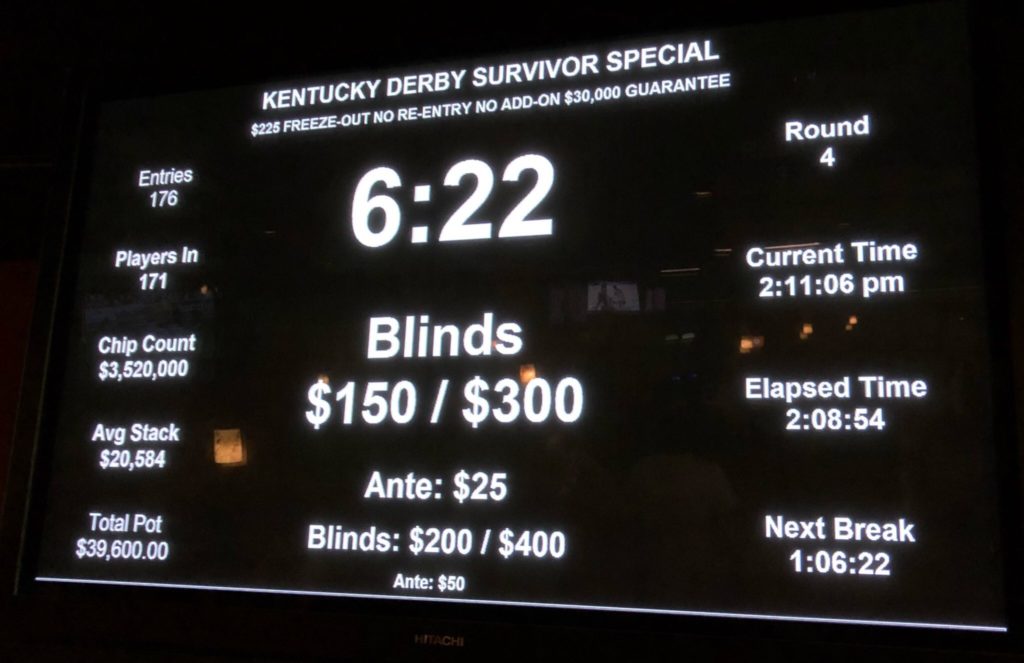Another unpublished piece from earlier this year that I thought was a lot less finished than it was. This is the kind of thing that happens when you work full-time, play a lot of poker, and spend hours each week writing and researching. Stuff falls through the cracks.
Last Friday night’s Final Table First Friday $20K GTD NLHE went pretty well for me, a nice continuation cash for the year and a good kickoff to the month before this year’s World Series of Poker season, which starts in just over three weeks. I played with no intention of rebuying.
I almost put my intention to the test when I played [9c 2c] from the BB (short story: let my aces get cracked by [9x 2x] in a $600 tournament at the Venetian six or seven years ago) and called a 3x raise with one other caller. The flop’s [9x 6x 2x] all red. The original raiser bet 1,200 and the caller goes all in for 2,900, I shove 10K or so, the original raiser folds, I’m up against [ax 6x] and the ace hits on the river.
Made it up to 60K after I busted a new player’s kings with [4h 6h] just after the first break, then there was a long, slide down to 40K by second break.

I was moved three times before the final table, with my last couple of tables featuring a very nice, slightly tipsy woman from Texas who claimed she didn’t have much experience playing poker, since it’s not legal there. She was very gregarious and doing extremely well despite her claims of inexperience. She made a couple of big calls that put her in flips (which she won), before losing a big chunk of her stack in a hand where she was ahead 70/30. She did have a tendency to risk more of her lead than might have been prudent.
Final Table @FinalTablePDX in the monthly First Friday $20K GTD pic.twitter.com/7UsX92rmyS
— Poker Mutant (@pokermutant) May 5, 2018
We took nearly an hour to go from 14 players to the final table, then another hour to lose two players. A player with about a quarter of the chips in play was in seat 1, talking non-stop, holding out for a bigger payout but also complaining about how tired he was. A couple of deals were proposed and I was the holdout until we were down to 8. The motormouth got $3K and everyone else got just over $2.5K.
The next day’s (technically, only about 7 hours after I got home) Portland Meadows Kentucky Derby $30K GTD NLHE Survivor tournament was one I was looking forward to, hoping to string two $2K cashes together in the weekend. Sadly, it was not to be. I lost chips, then took some from the always-aggressive Barron Nakama when I three-bet his raise with [ax kx]. I picked up [ac as] the very next hand and three-bet his raise again, with the flop coming [9x 7x 7x]. We ended up all-in and he, of course, had called my 3-bet with [ax 7x]. Chalk it up (again) to “old man with a big pair” syndrome.
I was down to 5,500, then managed to drive my way back up over 10K before I jammed over a 3-bet with [qx qx] from the cutoff, right into the button’s [kx kx]. I didn’t even make it to the end of buyins (no reentry).
Looking forward to the Final Table $50K GTD NLHE next weekend. Take time to appreciate your social club poker rooms and volunteer player/dealers, because it looks as if there may be another move from various governmental organizations to shut the whole thing down.
But enough of that. Let’s talk about survivor tournaments in general and the Ignition Casino $5K GTD Thousandaire Maker in specific.
Simply put, a Survivor tournament is similar to a satellite, where the prize pool is divided into equal-sized pieces. Most Survivor tournaments have a pre-defined payout, and everyone who makes it to the money gets the same amount of money (a ticket, in the case of a satellite). There is usually one exception: when the prize pool isn’t an even multiple of the payout amount, anything left over goes to the player who busts before the others are in the money.
As an example, if you have pre-defined payouts of $1,000 (as in the Thousandaire Maker) and a prize pool of $7,200, seven players would get $1,000 and the eighth would get $200. You can easily adjust payouts in any manner you like, and the payouts are simple to calculate. Have a $225 buyin and want to pay about 10% of the field? If 1 in 10 players is paid, the payout would be 10 times the buyin: $2,250. Got 176 players and a prize pool of $39,600? That’s 17 payouts of $2,250 and one of $1,350.
Want to extend to 15% of the field? Pay 6-2/3 (1/15×100) times the buyin: $1,500. Same number of entrants and prize pool is 26 full payouts (176×15%=26) with 27th getting $600. Better than a min-cash 7 out of 10 times even when you semi-bubble the Survivor.
The secret of the Survivor is that you need to be good and lucky to stay profitable playing poker tournaments. In Survivor tournaments you just need to be good. You don’t win the giant, sexy money, but if you can play them often enough, you can stay ahead of the rake. If you’re good enough.
I played my first Thousandaire Maker tournament on Bovada just over three years ago. In that time I’ve played a total of 149 Thousandaire Makers on Bovada and then Ignition. The payouts are $1,000. The buyin is $75+$7. I’ve cashed 16 events, with 16 full payouts and one semi-bubble. Cost to me: $12,218. Payout: $16,850 (nearly a full payout for the semi-bubble). Profit: $4,632. +38% ROI.
Only 7.5% of players get paid in the Thousandaire Maker, less than 1 in 13 entries. Since Bovada originally “sold” their poker operation to Ignition, I’ve only seen the number of entries get into triple digits once, so the number of $1K payouts has always been 5 (the guarantee), 6, or 7.
At least a couple of nights a week the Thousandaire Maker doesn’t run, not enough players have signed up by 8:15 Pacific (9 is the magic number) for the game to run.



